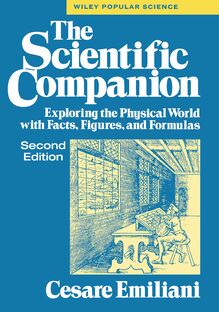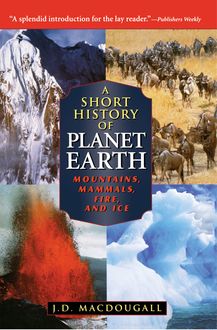The Scientific Companion, 2nd ed. , livre ebook
321
pages
English
Ebooks
2008
Vous pourrez modifier la taille du texte de cet ouvrage
Obtenez un accès à la bibliothèque pour le consulter en ligne En savoir plus
Découvre YouScribe en t'inscrivant gratuitement
Découvre YouScribe en t'inscrivant gratuitement
321
pages
English
Ebooks
2008
Vous pourrez modifier la taille du texte de cet ouvrage
Obtenez un accès à la bibliothèque pour le consulter en ligne En savoir plus
Publié par
Date de parution
21 avril 2008
Nombre de lectures
0
EAN13
9780470302873
Langue
English
Poids de l'ouvrage
1 Mo
This new edition of the critically acclaimed Scientific Companion offers a comprehensive introduction to the physical sciences: physics, astronomy, chemistry, geology, meteorology, biology, atmospheric science, and oceanography. Emiliani traces the evolution of the universe from the Big Bang to the present, explaining the nature of the galaxy, the Earth, inorganic and organic matter, and the development of scientific thought.
More than 50 new illustrations appear throughout--from stunning aerial shots of Earth's topography to striking close-ups of the moon provided by NASA. Hundreds of additional photos, charts, maps, and diagrams, plus 35 tables of the most essential facts, figures, and formulas--from Planck's constant to the laws of thermodynamics, from quantum energy levels to Avogadro's number--make The Scientific Companion an ideal desktop reference. Written for the layperson, sufficiently detailed for students, it is the only book of its kind to bridge the gap between works of popular science and college textbooks.
The Range of Space and Time.
Matter and Energy.
Atoms and Molecules.
The Sun.
The Evolution of the Sun and Other Stars.
The Origin and Evolution of the Universe.
The Origin and Evolution of the Solar System.
Planets and Satellites.
The Origin and Early Evolution of Life.
How the Earth Works.
Atmosphere.
Hydrosphere.
The Last Half-Billion Years.
The Cosmic Question.
Appendix.
Index.
Publié par
Date de parution
21 avril 2008
Nombre de lectures
0
EAN13
9780470302873
Langue
English
Poids de l'ouvrage
1 Mo
The Scientific Companion
The Scientific Companion
Exploring the Physical World with Facts, Figures, and Formulas
Second Edition
Cesare Emiliani
University of Miami
All original drawings by Charles Messing Nova University
Wiley Popular Science John Wiley & Sons, Inc. New York • Cichester • Brisbane • Toronto • Singapore
This text is printed on acid-free paper.
Copyright © 1995 by Cesare Emiliani Published by John Wiley & Sons, Inc.
All rights reserved. Published simultaneously in Canada.
Reproduction or translation of any part of this work beyond that permited by Section 107 or 108 of the 1976 United States Copyright Act without the permission of the copyright owner is unlawful. Requests for permission or further information should be addressed to the Permissions Department, John Wiley & Sons, Inc.
This publication is designed to provide accurate and authoritative information in regard to the subject matter covered. It is sold with the understanding that the publisher is not engaged in rendering professional services. If legal, accounting, medical, psychological, or any other expert assistance is required, the services of a competent professional person should be sought.
Library of Congress Cataloging-in-Publication Data
Emiliani, Cesare.
The scientific companion : exploring the physical world with facts, figures, and formulas / Cesare Emiliani : all original drawings by Charles Messing. — 2nd ed.
p. cm. — (Wiley popular science)
Includes index.
ISBN 0-471-13324-8 (pbk.)
1. Cosmology. 2. Evolution. I. Title. II. Series.
QB981.E58 1995
523.1—dc20
95-35530
10 9 8 7 6 5 4 3
This book is dedicated to Sandra and Mario Emiliani
Contents
INTRODUCTION
CHAPTER 1 The Range of Space and Time
Length
Time
Mass
How Big Is the Universe?
CHAPTER 2 Matter and Energy
Atoms
Protons, Neutrons, and Quarks
Electrons
Light
Spectra
CHAPTER 3 Atoms and Molecules
Elements and Isotopes
The Helium Atom
The Heavier Elements
Molecules
Temperature and Pressure
CHAPTER 4 The Sun
What Is the Sun?
The Photosphere
Inside the Sun
CHAPTER 5 The Evolution of the Sun and Other Stars
On Becoming a Red Giant
The Fate of Massive Stars
The Hertzsprung – Russell Diagram
The Radius of Stars
The Rotation of Stars
CHAPTER 6 The Origin and Evolution of the Universe
The Redshift
The Big Bang
Quasars and Galaxies
A Star Is Born
CHAPTER 7 The Origin and Evolution of the Solar System
Abundances of the Elements
The Early Solar System
CHAPTER 8 Planets and Satellites
Trigonometric Functions
Conic Sections
Planetary Motions
The Planets
Satellites
Asteroids
CHAPTER 9 The Origin and Early Evolution of Life
What Is Life?
The Cell
The Molecules of Life
The Origin of Life
The Earliest Organisms
Cell Replication
Early Life on Earth
CHAPTER 10 How the Earth Works
Composition
The Structure of the Earth
Isostasy and Heat Flow
Plate Tectonics
The Earth’s Magnetism
The Living Planet
CHAPTER 11 Atmosphere
Composition and Structure
Motions
Storms
The Seasons and the Year
CHAPTER 12 Hydrosphere
Composition
Circulation
Marginal Seas
Waves and Tides
Continental Waters
Ice
CHAPTER 13 The Last Half-Billion Years
The Earlier Paleozoic
The Later Paleozoic
The Mesozoic
The Cenozoic
CHAPTER 14 The Cosmic Question
APPENDIX
Table A1 Constants
Table A2 Conversion Factors
Table A3 Elements — Alphabetical List and Origin of the Names
Table A4 Elements and Isotopes
Table A5 Greek Alphabet
Table A6 Periodic Table of the Elements
Table A7 Units — Alphabetical List
Table A8 Units — Definitions
Table A9 Chemical Formulary
INDEX
Introduction
It is likely that when the human brain achieved its present size and complexity, about 125,000 years ago, humans began asking themselves questions about the world surrounding them. Questions like what is the sun? What makes the rain? Who makes the wind blow? Who makes lightning? Who made this world? What happens when one dies?
None of these questions could be answered, and so people invented gods. The most imaginative were the ancient Greeks, who, at the time of Homer and Hesiod, had a god, a goddess, or at least a nymph for practically everything. The very same Greeks, however, began finding answers to some of the questions, which reduced the number of divinities still needed. In the 25 centuries since then most questions have been answered. We now know what the sun is and why it shines, we know why the wind blows, how rain is made, and why lightning strikes. We also have a pretty good idea of what happens when we die (but do not want to admit it to ourselves).
Most of the answers about the nature of our physical world and the life in it have come only very recently, during this century and, more particularly, during the past few decades. Only the ultimate question—why did this world come into existence — is still up in the air (see Chapter 14 ) and may even be inherently unanswerable.
Our world is an incredibly coherent system endowed with a rich braid of evolutionary paths from its fiery beginning 15 billion years ago to the evolution of humans on Earth. The recent discoveries make it now possible, for the first time in history, to construct an evolutionary model of the physical universe and of the life in it that fits all observations and does not violate any of the laws of nature. The dream of the ancient Greeks has come true.
Yet, modern societies still react to their environment and to each other as though nothing had happened. Ancient gods and discredited symbols still hold an amazing sway on the human mind and still cast one society against another into endless conflict. Restructuring of ethical, political, and religious thinking within the framework of the universal system that has been revealed to us now appears to be both a noble purpose and a prime necessity. This effort, if accompanied by a worldwide educational drive, will help resolve some of the more vexing problems that beset our modern world. Indeed, understanding the system will help humans manage that minuscule but vital part that they control—Planet Earth.
The purpose of this book is not only to describe how our world originated and evolved, but to provide the reader with a quantitative basis and a feeling for the dimensions involved. This approach will enable the reader to reach a personal appreciation of the awesome beauty and wondrous workings of the system of which we all are part, and to draw from it both comfort and guidance.
C ESARE E MILIANI
Palm Beach Gardens, Florida
C HAPTER 1
The Range of Space and Time
We move through space. We live through time. Our bodies have mass. These are basic quantities, space—time—mass. How are they measured?
Until 200 years or so ago, each country, and often each province or even each city, had its own system of measurement. This was of course very confusing, especially to merchants and travelers. So, in the year 1790 the French Assembly ordered the French Academy to come up with a system that everybody could use. The Academy complied and developed the metric system, which was adopted in France on November 2, 1801. It has been adopted by most other countries since then. The unit of mass in the metric system is the kilogram, which is just about the mass of 1 liter of water. The unit of length is the meter, which is about 3 feet, 3 inches. The unit of time is the second, which is close to the length of a heartbeat.
We will use the metric system throughout this book. If you are not familiar with it, you will learn it as you go along. It is important, however, to associate directly the metric name with the quantity it represents (for example, kilogram to the mass it represents and meter to the length it represents). You should not try to translate a metric unit into the corresponding English unit and then associate that unit with the quantity it represents. Learning the metric system is like learning a foreign language—direct association is important. There is a conversion table in the Appendix to help you.
LENGTH
The unit of length in the metric system is the meter. The French Academy defined the meter as one forty-millionth (1/40,000,000) of a circle drawn on the earth’s surface and passing through the poles. Any such circle consists of two opposite meridians, one running from the North Pole to the South Pole and the other one running from the South Pole to the North Pole on the opposite side of the earth.
The modern definition of meter is the distance traveled by light in empty space in 1/299,792,458 of a second, which derives from the fact that light travels in empty space at the speed of 299,792,458 meters per second. Because the speed of light in empty space never changes, this is a good way to define the meter.
The meter is a nice unit to measure people, furniture, and houses. For lengths more than a city block, the kilometer is used. One kilometer is equal to 1000 meters.
For smaller lengths, the centimeter is used, which is equal to one-hundredth (1/100) of a meter, or about the width of the fingernail on your little finger.
For even smaller lengths, the millimeter is used, which is equal to one-thousandth (1/100) of a meter, or about the width of a tooth on the margin of a postage stamp.
For really small lengths, the micrometer is used. This is equal to one-millionth (1/1,000,000) of a meter. It is the length of a small bacterium. We cannot see bacteria without a powerful microscope, which is too bad because bacteria can be charming, and we owe them a lot for having developed the basic biochemistry of life some four billion years ago.
TIME
The unit of time is the second. The second was originally defined as 1/86,400 of a mean solar day, simply because there are 86,400 seconds in one day (24 hours × 60 minutes × 60 seconds = 86,400 seconds).
The length of the day, however, changes slightly as

